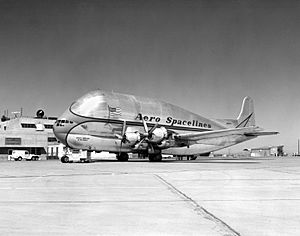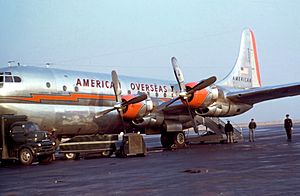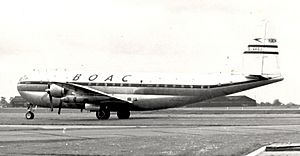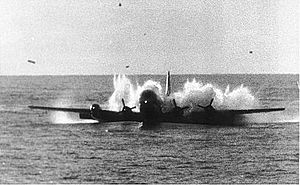Boeing 377 facts for kids
Quick facts for kids Boeing 377 Stratocruiser |
|
|---|---|
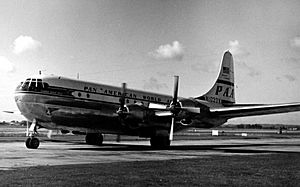 |
|
| Pan Am Stratocruiser Clipper Seven Seas arriving at London Heathrow in September 1954. | |
| Role | Airliner |
| Manufacturer | Boeing |
| First flight | July 8, 1947 |
| Retired | 1963 |
| Status | Retired |
| Primary user | Pan Am |
| Number built | 56 |
| Developed from | Boeing C-97 Stratofreighter |
| Variants | Pregnant Guppy Super Guppy Mini Guppy |
The Boeing 377, also known as the Stratocruiser, was a large passenger airplane. It was built by the Boeing company right after World War II. This plane was developed from a military transport aircraft called the C-97 Stratofreighter. The C-97 was itself based on the famous Boeing B-29 Superfortress bomber. The very first Stratocruiser flew on July 8, 1947.
The Stratocruiser had four powerful piston engines. It was special because it had a pressurized cabin and two decks. This meant passengers could fly comfortably at high altitudes. Airlines could use the Stratocruiser for much longer flights, reaching far-off places like Hawaii.
However, the Stratocruiser was quite expensive to buy and operate. Other planes, like the Douglas DC-6 and Lockheed Constellation, were cheaper. Because of this, only 55 Stratocruisers were made for airlines.
Contents
Building the Stratocruiser
The Boeing 377 used parts from the B-50 Superfortress, like its lower body and wings. It was larger than its competitors, the Lockheed Constellation and Douglas DC-6. It could also fly for longer distances without stopping. Boeing stopped making the 377 in 1950.
A cool feature was its cabin pressurization system. This technology was first used on the Boeing 307. It meant that even if the plane was flying very high, like at 15,500 feet (about 4,700 meters), passengers would feel like they were much closer to the ground. This made flights more comfortable.
History of the Stratocruiser
A total of 56 Stratocruisers were built. Most of these, 55 planes, were made for different airline companies.
The Stratocruiser flew to many destinations, including Hawaii. It was one of the few planes at the time that had two decks for passengers. Another plane with two decks was the Breguet Deux-Ponts. This two-deck design was not common again until the much larger Boeing 747 was introduced many years later.
In the early 1960s, newer jet planes started to appear. These included planes like the de Havilland Comet, Boeing 707, and Douglas DC-8. Jet planes were faster and more efficient. Because of this, the Stratocruiser slowly became less popular and was retired by airlines.
Different Kinds of Boeing 377
Over time, a few different versions of the Boeing 377 were made.
- 377-10-19
- This was the very first test plane, called a prototype. It was later given to Pan American World Airways in 1950.
- 377-10-26
- Twenty of these planes were built for Pan American World Airways.
-
- 377-10-26S
- This was an improved version of the 377-10-26. Ten of these planes had better engines and could carry more fuel. They were known as the "Super Stratocruiser".
Many other small changes were made to planes, often just to the shape of the windows.
Aero Spacelines Guppy
In the 1960s, a company called Aero Spacelines began changing some 377s. They turned them into special cargo planes called Guppies. These planes looked very unusual because they were designed to carry very large parts, like rockets.
There were three main types of Guppy planes: the Pregnant Guppy, the Super Guppy, and the Mini Guppy. The Super Guppy and Mini Guppy versions were updated with turboprop engines, which are a mix of jet and propeller engines.
Who Used the Stratocruiser?
Many airlines and even some air forces used the Boeing 377 Stratocruiser.
- Línea Internacional Aérea
- Israeli Air Force
- American Overseas Airlines
- Northwest Orient Airlines
- Pan American World Airways
- Transocean Air Lines
- United Airlines
- Rutas Aéreas Nacionales SA
Accidents
The Stratocruiser was involved in 13 "hull-loss" accidents between 1951 and 1970. A hull-loss accident means the plane was damaged so badly it could not be repaired and had to be written off. Sadly, 140 people died in these accidents.
Related pages
- Aircraft related to this one
- Bibliography
- Air Disaster, Vol. 4: The Propeller Era, by Macarthur Job, Aerospace Publications Pty. Ltd. (Australia), 2001 ISBN: 1-875671-48-X
Images for kids
-
A United Airlines 377 over the Golden Gate Bridge
-
A BOAC Stratocruiser
-
Pan Am President Juan Trippe in front of a 377
See also
 In Spanish: Boeing 377 para niños
In Spanish: Boeing 377 para niños


